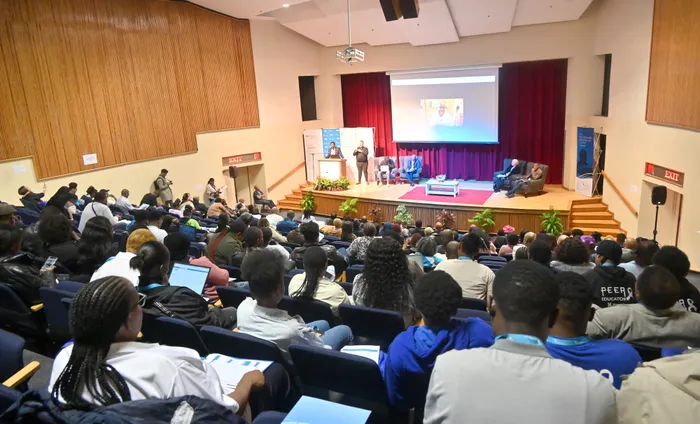Higher education in South Africa still for a select few

Picture: Ayanda Ndamane / African News Agency (ANA) / taken March 7, 2023 – CPUT hosts its very first Gender-based Violence Research Indaba, looking at GBV at institutions of higher learning. Higher Education, Science and Innovation deputy minister Buti Manamela gives the keynote address.
By Jabulani Sibande and Anthony Kaziboni
To redress past injustices, colonialism and apartheid, the newly established democratic South African state listed access to education as a constitutional right. Black South Africans had been racially excluded from access to basic social services and rights, like education, by the racist states. This further relegated the masses to poverty in perpetuity.
Education is a crucial determinant of upward social mobility. In the new South Africa, people's access to education significantly influences their life chances and those of their offspring. Higher education places people in a position to seek higher-income jobs. The systematic exclusion of black people from accessing higher education on the basis of affordability limits transformation in society. In addition, it undermines the social fabric on which the constitution is founded on equality.
Early this year, the Minister of Basic Education, Angie Motshega, announced that the matric class of 2022 produced 278,814 bachelor passes – students who qualified for university placements. Unfortunately, public universities can only admit 200,000 first-year students in 2022 alone, despite receiving over a million applications.
Moreover, the minute portion that makes it to universities faces financial challenges that affect access to food, accommodation and tuition fees. These challenges contribute to at least half of first-year students dropping out of universities yearly. As a result, the 200,000 admitted first-year students is halved, raising the percentage of displaced students, those who applied and those who dropped out to 92.5 percent.
Education is the key to upward social mobility, and it is necessary to address the triple challenge - inequality, poverty, and unemployment. Globally, South Africa is the most unequal country, with a meager 10 percent of the population owning more than 85 percent of household wealth. Half of the adult population lives below the poverty line and the unemployment rate is 34.5 percent.
The rising number of student protests at the beginning of every academic year is worrying. While any South African can access higher education after admission, financial exclusion reduces the chances of people from previously disadvantaged groups, mostly disproportionately black, accessing higher education.
Additionally, it has become apparent that the 26 public universities are inadequate to the growing demand. Since 1994, only nine universities have been founded, which is nowhere near enough. There are plans to construct two more universities.
In a rapidly changing world catalysed by the Fourth Industrial Revolution (4IR), it is more critical now than ever for the youth to gain admission and skills that will assist them in the new world. If an increasing number of people are excluded, it can only mean that we will have people without the skills to secure or create employment in the near future. Exposing the youth to new curriculums in universities that will equip them with the skills to navigate the 4IR will help the country to move forward.
Despite the number of universities available and funding for disadvantaged students, a peculiar group still struggles to access higher education – the missing middle. These students come from working-class families who do not qualify for the National Student Financial Aid Scheme (NSFAS) and cannot afford higher education.
Students’ fight for their right to education was the main instigator of the #FeesMustFall Movement. The movement fought against increasing student fees and limited state funding for universities. As a result, the NSFAS introduced the Acknowledgement of Debts document, which allows students with outstanding fees to register after signing this document. Second, a few adjustments to the loan require students to pay back 60 percent only if their income exceeds R30,000 [KA1] [SJ2]. Therefore, this privilege is not afforded to the missing middle, and the NSFAS needs to consider this.
In his first address for 2023, the Minister of Tertiary and Higher Education, Dr Blade Nzimande, acknowledged that the missing middle is a grave concern for the department. The address was mainly aimed at the mounting student debt which has passed the 16 billion mark. Some institutions have sought donations to assist the missing middle to enroll.
This year, the University of Johannesburg (UJ), for example, launched the Double our Future Impact campaign that was set to help up to 10,000 students with registration fees. UJ's newly appointed Vice-Chancellor and Principal, Professor Letlhokwa Mpedi, demonstrated leadership by contributing R50,000 towards the campaign. Beyond the government, business, or private sector, it also has a role in funding higher education.
It is an understatement to say that the South African education system needs reforms. The country is at a time when more graduates are unemployed than ever, with only 30 percent finding employment after graduating. There is a need for a crisis management strategy for higher education and unemployment.
Sibande is an Assistant Researcher at the Institute for the Future of Knowledge, University of Johannesburg. Dr Kaziboni is the Head of Research at the Institute for the Future of Knowledge, University of Johannesburg